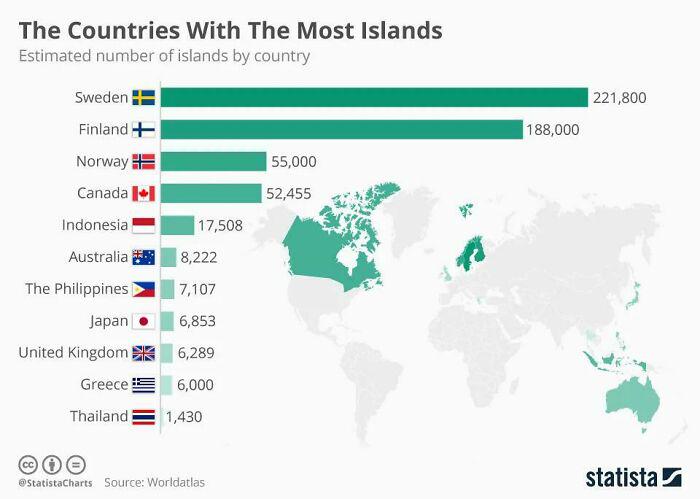Countries with Most Islands Map


Alex Cartwright
Senior Cartographer & GIS Specialist
Alex Cartwright is a renowned cartographer and geographic information systems specialist with over 15 years of experience in spatial analysis and data...
Geographic Analysis
What This Map Shows
This map highlights the countries that boast the highest number of islands, providing a visual representation of these landmasses scattered across various oceans and seas. From the vast expanses of the Pacific to the intricate coastlines of the Caribbean, the number of islands varies dramatically from one country to another. The visualization allows us to see not just the sheer count of islands but also hints at the geographical diversity and ecological richness that these islands represent.
Deep Dive into Countries with Most Islands
When we think of islands, we often imagine tropical paradises with sandy beaches and palm trees. However, islands come in various forms, sizes, and ecosystems. The countries with the most islands are often characterized by their geographical locations and historical contexts. For instance, Sweden tops the list with over 221,800 islands, many of which are uninhabited and offer unique ecosystems and habitats.
Interestingly, the sheer number of islands does not always correlate with the size of the country. For example, Finland has around 188,000 islands, while Indonesia, known for its vast archipelago, has about 17,508. The presence of these islands can be attributed to tectonic activities, glacial processes, and rising sea levels. In places like Sweden and Finland, the land uplift from glacial rebound has created numerous islands as the seas receded.
Moreover, the biodiversity found on these islands is often astounding. Many islands serve as refuges for unique flora and fauna, promoting ecological diversity. For example, the Galápagos Islands in Ecuador are famous for their distinct species that influenced Charles Darwin's theory of evolution. Similarly, the islands of Indonesia host some of the most biodiverse ecosystems on the planet, making them key areas for conservation efforts.
Notably, the geographical distribution of islands also plays a crucial role in cultural and economic aspects. Countries like Japan, comprised of over 6,800 islands, have developed rich traditions and practices that are closely tied to their maritime environments. Fishing, tourism, and trade are often pivotal to the economies of these island nations, emphasizing how islands can shape the livelihoods of their inhabitants.
Regional Analysis
The map really brings to light how different regions of the world are affected by their islands. In the Caribbean, countries like the Bahamas and Cuba are surrounded by numerous islands, which not only attract tourism but also influence local economies and cultures. The Caribbean islands are renowned for their vibrant cultures and biodiversity, making them a hot spot for travelers looking for both adventure and relaxation.
In contrast, regions like the Arctic showcase a different type of island environment. Countries such as Canada and Russia are home to numerous islands that are often less populated and have rugged terrains. These islands are crucial for research on climate change and biodiversity, as they represent some of the last untouched ecosystems on Earth. Canada’s Arctic Archipelago, for example, contains over 36,000 islands, many of which are critical for understanding global climate shifts due to their sensitivity to temperature changes.
In the Pacific, nations like Fiji and the Solomon Islands reveal a different narrative. These countries are often characterized by vibrant marine life and coral reefs, making them essential for eco-tourism and marine conservation. The islands here are not just geographical features; they are integral to the cultural identity of their inhabitants, who have lived in harmony with the sea for generations.
Significance and Impact
Understanding the distribution and significance of islands is more than an academic exercise; it has real-world implications. With ongoing climate change and rising sea levels, many island nations are facing existential threats. The Maldives, for example, is one of the most prominent cases, with predictions suggesting that parts of the country could be underwater within a few decades.
Moreover, the geopolitical implications of islands cannot be overlooked. The South China Sea, dotted with numerous islands, has become a flashpoint for territorial disputes. Countries are vying for control over these areas not just for national pride but also for the resources that lie beneath them.
In conclusion, the countries with the most islands map offers a fascinating glimpse into the geographical and ecological complexities of our planet. The number of islands can tell us stories about biodiversity, culture, and even the challenges faced by nations in a rapidly changing world. As we continue to study and understand these islands, we gain valuable insights into the importance of protecting these unique ecosystems for future generations.
Visualization Details
- Published
- September 19, 2025
- Views
- 62
Comments
Loading comments...